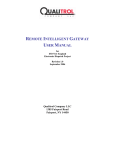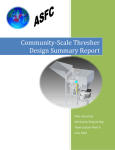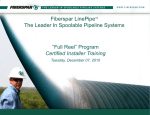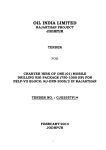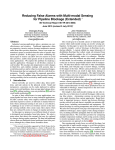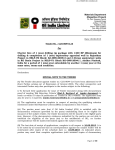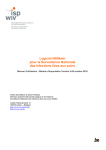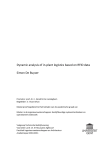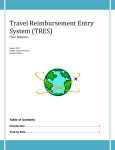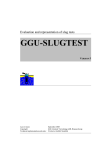Download WELL INFORMATION SYSTEM MANUAL
Transcript
W S WELL INFORMATION SYSTEM MANUAL WELL INFORMATION SYSTEM System Overview SCHEDULED QUERIES – This allows the user to set up scheduled reports that inform them of new activity or permit filings in regions defined by the user. DRILLING PERMIT QUERY – Historical permits filed over the past 25 months complete with Operator address and contact information. Search the extensive national RigData database on state, district, county, region, well orientation, well class, permit type, API, PTD and more. VIEW YOUR REPORTS – This section allows users to view the current issue of the standard or special reports to which they subscribe. WELL LOCATION & DRILLING ACTIVITY QUERY – Build and save queries based on drilling contractor, operator, currently drilling, released, historical spuds, not to mention state, district, county and region. BACK ISSUES – This section allows users to view back issues of the standard or special reports to which they subscribe. COLUMN TEMPLATES – This allows users to save a list of columns that can be applied to any query. RIG SPECIFICATION QUERY – This section allows you to build queries that show the history of a rig, currently active rigs and the areas in which they are being used as well as their individual specifications. We show rig type, power type, drawworks, horsepower, primary work area as well as each individual drill associated with that rig. Revised July 9, 2013 1 List Pages The List Pages within each of the query type boxes display’s the user’s queries and the user’s shared queries. Here the user can add new queries and edit the existing queries. The user can also copy existing queries, or go directly to the results or map pages. Button Explanation DATA – This button links directly to the Results Page. The data for the query is displayed. SCHEDULE QUERY – T his button redirects the user to the Create Schedule Query page. This will allow them to create a new scheduled query based on the selected query. MAPS – T his button places markers on a Google map based on the latitude and longitude of the permit or drilling location that the query returns based on the current query. The marker displays rig and driller information. DELETE – Deletes the query permanently. EDIT – Opens the query for editing and allows users to make changes to query criteria. COPY – C reates a new copy of the query. Adding “Copy of“ to the query name, the user can then open the query and rename it or make changes to criteria. NEW QUERY – Redirects the user to the Edit Query page to create a new query. DATE RANGES – T he date range boxes on the Permit and Location sections allow the user to change the dates and go directly to the result data without having to edit the query. To change the range, select different start and end dates and then select “Data”. SHARED QUERIES – T his displays the queries that other users have shared with you. Each user can create a query and share it with anyone within their group thereby allowing others to run the same information inside the system. These shared queries are read only. However, they can be copied to your queries so one can make changes to the criteria. Revised July 9, 2013 2 Permit Queries To create a new query from the home page, click on the “Drilling Permit Query” section. Then click on the “New Query” Button. Query Name is used as a description of the query. It can be anything the user wants to enter. This is a required field. Date Range Section DATE TYPE – T his drop down allows the user to select “Permit Posted Date” or “Permit Approval Date”. The Permit Posted Date is the date that the permit was posted with the state. The “Permit Approval Date” is the date that the state approved the location. DATE RANGE – This drop down gives the user options to use a predetermined date range or a custom date range. If “Custom” is selected, the Date From and Date To text boxes will appear. DATE FROM AND DATE TO – The date range that the query uses to filter the time range. These are required fields. INCLUDE PENDING CHECK BOX – This will tell the query to include pending permits. Revised July 9, 2013 3 Geography Section The Geography Section of the Permit Query allows the user to set the region, state/district and county/parish. This section is broken into three components. The first component is the region set which is a predetermined area that is made up of a group of counties or parishes. The region can be one of the RigData standard regions or a custom region (signified by an *) built in the admin site. The second component is a list of state district combinations. The third is the county list, which is made up of the list of counties from the first two components. REGION – This is a group of counties or parishes that are assigned a name and ID. COUNTY/PARISH – Surface location county. STATE/DISTRICT – This is a list of state/district combinations. >, <, >>, << BUTTONS – T he > and < buttons are used to move items between two lists. Users can hold down the “ctrl” key and select multiple items and move them over all at once using the < or > buttons. The << and >> buttons are used to move all items from one list to another. SHOW INLAND WATERS CHECK BOX – A ll “State/District” items that are of type “Land” will be added or removed based on the checked status of this check box. SHOW OFFSHORE DISTRICTS CHECK BOX – A ll “State/District” items that are of type “Offshore” will be added or removed based on the checked status of this check box. This will also affect the “County /Parish” list box Revised July 9, 2013 4 Well Information Section PERMIT TYPE – State permit type. WELL CLASS – Well classification. PURPOSE – Purpose of the well (Exploratory or Development). ORIENTATION – Well orientation (Vertical/Horizontal/Directional). H2S – Denotes whether or not H2S (Hydrogen Sulfide) gas is present (True/False). API – API Well Number. This can be entered as a comma separated value for multiple API numbers. (Example: “35-049-24055-A, 05-123- -, 42-003- -, 42-135- -, 42-003- -“). PTD – Proposed total depth. LEASE NAME – Registered name on Lease. Revised July 9, 2013 5 Operator Section The Operator Section allows the user to search for specific operators to include in the query. First, the user selects the search type, then they select what field they would like to search by, and finally, they enter the search string. The user clicks the search button and a list of operators is returned. The user can then add or subtract the operator from the query. SEARCH TYPE – This allows the user to select what type of search they would like to perform: • EXACT – Will look for an exact match to the string that is supplied. • STARTS WITH – Will search for any value that begins with the string supplied. • ANYWHERE IN FIELD – Searches for the string in any part of the field. SEARCH FOR FIELD – Allows the user to select what field to use in a search. TEXT STRING BOX – The string that is used in the search. RESULTS GRID – This is the grid that displays the results returned by the search. SELECTED GRID – The grid that displays the operators selected by the user. ADD BUTTON – Adds an operator on that row to the selected grid. ADD ALL BUTTON – Adds all operators in the results grid to the selected grid. REMOVE BUTTON – Removes the operator from the selected grid. REMOVE ALL BUTTON – Removes all operators from the selected grid. Revised July 9, 2013 6 Sharing Section The Sharing Section allows the user to select other users from their group with whom to share the query with. Output Section RESULT TYPE There are six result types to choose from: WELL RECORD RESULTS – Result set displayed in a grid that can be sorted and exported. WELL RECORD REPORT – Detail report for the record selected by the user. CONTACT RESULTS – Contact fields result set displayed in a grid that can be sorted and exported. CONTACT REPORT – Operator contact detail report for the record selected by the user. SUMMARY REPORT – A brief well record summary that depicts grouped information with charts. SCHEDULED QUERY – Creates a scheduled query for the selected query. Revised July 9, 2013 7 Well Record Results/Contact Record Results Result Format This section allows the users to select whether they would like to view the results in a grid or export them to a specific format. Columns Section This section allows the users to select the columns that they want to display in the results. The system also allows the user to create “Column Templates”. This will be discussed later in the training. Clicking the “Sort By Column Name” will sort the column names in the left column list box by column name. Also the text of the “Sort By Column Name” will change to “Sort By Column Order”. Clicking it again will sort the columns by the order they are in the database. After the user clicks the “Run Query” button it will take them to the results page. Revised July 9, 2013 8 Export File This result format allows the user to export the result set into various file formats. This can also be done from the results page. FILE NAME – Name of the file to be exported. FILE DESCRIPTION – Description of the file that is created. FILE TYPE – User can select XLS, XLSX, XML or CSV. After entering this information, the user clicks the “Export” button. This will take the user to the Export Page. They can then click on the name of the file to download the file. They can also click on the query name to go back and edit the query that was used to create the exported file. Revised July 9, 2013 9 Well Record Report/ Contact Report/ Summary Report After selecting “Well Record Report”, “Contact Report“, or “Summary Report” from the “Result Type” drop down, click the “View Report” button. The file download will start. The user will be given the option to open or save the file to their local machine. When the file is open, it will look like one of the following: Location Summary 2176 Well Starts NOVEMBER 14, 2011 Currently Active Rank Top Operators Well Starts Dir/Hoz Cnt PTD AVG PTD 1 CHESAPEAKE OPERATING, INC. Operator Oklahoma City 137 128 1,505,510 1,505,510 2 PIONEER NATURAL RESOURCES USA, INC. Irving 56 15 747,773 747,773 3 DEVON ENERGY PRODUCTION COMPANY, LP Oklahoma City 56 50 607,043 607,043 4 CONTINENTAL RESOURCES, INC. Enid 41 39 266,318 266,318 5 EOG RESOURCES, INC. Corpus Christi 31 28 358,800 358,800 6 COG OPERATING, LLC Midland 31 9 286,317 286,317 7 ANADARKO E & P COMPANY, LP Houston 28 27 299,824 299,824 8 APACHE CORPORATION Tulsa 27 6 259,415 259,415 9 WHITING OIL & GAS CORPORATION Denver 25 22 289,836 289,836 10 CHESAPEAKE APPALACHIA, LLC Charleston 23 23 155,707 155,707 11 MARATHON OIL COMPANY Houston 23 23 214,588 214,588 12 SANDRIDGE EXPLORATION & PRODUCTION, LLC Oklahoma City 22 9 140,163 140,163 13 XTO ENERGY, INC. Tyler 22 17 346,880 346,880 14 TALISMAN ENERGY USA, INC. Horseheads 20 20 190,957 190,957 15 EXCO OPERATING COMPANY, LP Dallas 19 19 267,000 267,000 16 PETROHAWK OPERATING COMPANY Houston 18 18 241,500 241,500 17 NOBLE ENERGY, INC. Denver 17 9 131,838 131,838 18 ENDEAVOR ENERGY RESOURCES, LP Midland 17 1 206,700 206,700 19 XTO ENERGY, INC. Oklahoma City 17 17 140,412 140,412 20 ENERGEN RESOURCES CORPORATION Midland 16 6 169,500 169,500 646 486 6,826,081 * Only top 20 points represented City COPYRIGHT © 2011 RIGDATA P.O. Box 820547 Fort Worth Texas 76182-0547 1-800-627-9785 | www.rigdata.com This report is protected under United States and international copyright laws and is intended for the exclusive use of the subscriber. Any unauthorized reproduction, retransmission, distribution, publication, broadcast or circulation of this report to anyone, directly or indirectly, without the express prior written consent of RIGDATA is prohibited. To order additional report copies at a reduced rate or for a corporate site license, please contact: 1-800-627-9785 11/14/2011 2:38 Permit Results Report Revised July 9, 2013 Permit Contact Report 10 Summary Report Scheduled Query When the user clicks the “Create Scheduled Query”, the user will be redirected to a page that will allow them create a new scheduled query. This feature allows the user to schedule a saved query to run and send the results in a selected output to an email account or FTP site. They are able to schedule this query to run on a monthly, weekly or daily schedule. OFF/ON DROP DOWN – The user can enable or disable the scheduled query. RESULT TYPE – This control allows the user to select what type of output the query will return. FILE DESCRIPTION – Description of the file that is being created and attached to the email. Revised July 9, 2013 11 FILE TYPE – The possible file types that can be created and attached to the email sent. • Excel (XLS) Limited to queries that return less than 65,000 records. • Excel (XLSX) Can be used for queries that return over 65,000 Records. • XML • CSV • PDF FREQUENCY – The regularity by which the query is run and emailed to users • Daily • Weekly • Monthly RECIPIENTS – The list of users that the query is sent to. The query owner is automatically added to the list. After the user saves the scheduled query, the user will be taken to a list of scheduled queries for that user. From this page the user can “Edit” a scheduled query or “Delete” them. Revised July 9, 2013 12 Location Queries The Location Queries have the same List Pages with the following differences. CURRENTLY ACTIVE – Used instead of actual dates, represents spud in the past and no release date. SPUD DATE – Date the rig began drilling the well. RELEASE DATE – Date the rig was released from the well. PERMIT POSTED DATE – Date the permit was entered into the RigData System. PERMIT APPROVAL DATE – Date the permit was approved. Revised July 9, 2013 13 Driller Section The Driller Section is similar to the Operator Search on the Permit Query section. This section can be used to query the driller company information. SEARCH TYPE – This allows the users to select what type of search they would like to perform: • EXACT – Will look for an exact match to the string supplied. • STARTS WITH – Will Search for any value that begins with the string supplied. • ANYWHERE IN FIELD – Searches for the string in any part of the field. SEARCH FOR FIELD – Allows the user to select what field to use in the search. TEXT STRING BOX – The string that is used in the search. RESULTS GRID – This is the grid that displays the results returned by the search. SELECTED GRID – The grid that displays the drillers selected by the user. ADD ALL BUTTON – Adds all drillers in the results grid to the selected grid. REMOVE BUTTON – Removes the driller from the selected grid. REMOVE ALL BUTTON – Removes all drillers from the selected grid. Revised July 9, 2013 14 Output The ”Contact Report” and “Contact Results” output types have an extra required selection; whether the contact data that is returned is the driller or operator information. Revised July 9, 2013 15 Rig Specification Queries This drop down sets whether the results will include active, inactive or both rig types. Market/Status RIG STATUS – S tatus of the rig (out of service, international, inventory, planned construction, refurb in service, refurbishing, sold, transferred, under construction). CURRENT MARKET – Area that rig has or is generally drilling. OFFSHORE MARKET – General body of water where the rig is or has been drilling. “LAND/OFFSHORE” drop down – T his control will filter the possible items in the current market and offshore market by land markets or offshore markets. Revised July 9, 2013 16 Driller Section The Driller Section is similar to the Operator Search on the Permit Query section. This section can be used to query the driller company information. SEARCH TYPE – T his allows the user to select what type of search they would like to perform: • EXACT – Will look for an exact match to the string that is supplied. • STARTS WITH – Will Search for any value that begins with the string that is supplied. • ANYWHERE IN FIELD – Searches for the string in any part of the field. SEARCH FOR FIELD – Allows the user to select what field to use in the search. TEXT STRING BOX – The string that is to be used in the search. RESULTS GRID – This is the grid that displays the results returned by the search. SELECTED GRID – The grid that displays the drillers selected by the user. ADD ALL BUTTON – Adds all drillers in the results grid to the selected grid REMOVE BUTTON – Removes the driller from the selected grid. REMOVE ALL BUTTON – Removes all drillers from the selected grid. RIG NUMBER – As drillers are selected, the rig number list box is updated with the rigs that are associated with that driller. Revised July 9, 2013 17 Rig Specifications Because of the amount of data associated with this section, we have given the user the ability to search for specific items for each field. The user can enter a search string in the textbox and click the “Find” button and it will populate the list box below. The user can then add the selected items to the query. MANUFACTURER – Company that built the rig. MODEL – The model of the rig. DRAWWORKS – T he hoisting mechanism on a drilling rig. It is essentially a large winch that spools off or takes in the drilling line and thus lowers or raises the drill stem and bit. HORSEPOWER FOR FIRST DRAW WORKS – Rated engine horsepower for the drawworks. DRAWWORKS ENGINE – Manufacturer of the engine in the drawworks. POWER – Power Type (elec, mech, vfd, scr, ac, dc/dc, hydr). ENGINE TYPE – A diesel, LPG, natural gas, or gasoline engine along with a mechanical transmission or generator for producing power for the drilling rig. MUD PUMP – D evice that increases the pressure on a fluid or raises it to a higher level. Various types of pumps include the bottom hole pump, centrifugal pump, hydraulic pump, jet pump, mud pump, reciprocating pump, rotary pump, sucker rod pump and submersible pump. WELL CONTROL – Identifies the well control system used. MAX DRILLING DEPTH RATING – Maximum drilling depth. ENGINE HP RATING – Horsepower of the engine. DRAWWORKS HP RATING – Horsepower rating listed for the drawworks on the rig. MUD PUMP HP RATING – Horsepower rating for the mud pumps. Revised July 9, 2013 18 Results Page The Results Page displays the record set returned by the query in a grid. The user can view detailed information for each record. The record set can also be sorted in the grid or exported to a format of their choosing. Results Screen EDIT QUERY – Redirects to the edit query page. VIEW MAP – Redirects to the Map Page and plots the result set on a Google map. EXPORT – Allows the user to export the current result set to Excel, XML or CSV format. “NUMBER OF RECORDS TO DISPLAY” drop down – D rop down that allows the user to select a numeric value of records to view in the results grid. DETAIL ICON COLUMN Revised July 9, 2013 – This button is used to view the detail information for this record. 19 Result Export This result format allows the user to export the result set into various file formats. This section also allows the user to select what rows will be exported. • FILE NAME – Name of the file to be exported. • FILE DESCRIPTION – Description of the file that is created. • FILE TYPE – User can select XLS, XLSX, XML or CSV. • EXPORT BUTTON – Exports all of the result set to the file type selected. • EXPORT SELECTED BUTTON – Only exports the rows that have been checked by user. Sorting Results Clicking on the header of any row in the result grid will make the grid sort by ascending order in that column. Click it again and it will sort the same column by descending order. Revised July 9, 2013 20 Filtering Results Filtering allows the user to create a more defined dataset. To apply a filter, the users will enter the text that they want to filter by into the textbox below the column header. Then the user will click the funnel icon to the right of the textbox. After the button is clicked, a list of filter options will appear. After the option is selected, the filter will begin. To remove the filter, select “No Filter” from the option list. Revised July 9, 2013 21 Grouping Results Grouping will organize the result data into related joins based on the column that is used to group the data. For example – Let us say I want to arrange the result set to have all the records that have the state column equal to Texas in one section. To do this, the user will click and drag the column header to the gray row above the column headers. (Orange arrows will identify this row while the user is dragging.) Now the grid will rebuild, and the user should see a grid that has drill down rows based on the column they selected to group by. The users can collapse and open the groups as they wish. To remove the groupings, all the users have to do is click the column that they added to the group row and drag it back to the grid. The groupings will then be removed. Revised July 9, 2013 22 Detail Screen The Detail Section displays specific information for the selected record. The user selects the record by clicking on the magnifying glass icon in the first column of the record. This will then take them to a detail page where they can view the information. They can also print the detail information and view the actual scanned document that produced the data. They can also view the location on a Google map. API NUMBER – American Petroleum Institute Well Code LEASE NAME – Lease Name WELL NUMBER – Surface Location Well Number STATE NAME – State of Location COUNTY – County of Location DISTRICT – District of Location WELL CLASS – Well Classification WELL ORIENTATION – W ell Orientation (Vertical/ Horizontal/Directional) PROPOSED TOTAL DEPTH – Proposed Total Depth FIELD NAME – Field 1 of Well FIELD NAME 2 – Field 2 of Well FIELD NAME 3 – Field 3 of Well FIELD NAME 4 – Field 4 of Well FIELD NAME 5 – Field 5 of Well COMMENT – Comment Surface DRILLERNAME – Name of Drilling Company DRILLER ADDRESS – Address of Drilling Company DRILLER FAX – Fax Number for Drilling Company PERMIT APPROVAL DATE – Date Permit was Approved PERMIT NUMBER – Number on permit NEW PERMIT FLAG – D enotes permit filed within the past 7 days Revised July 9, 2013 PERMIT TYPE – Work Type (i.e. original drill, workover, recompletion, sidetrack, etc.) OPERATOR NAME – Name of Operating Company CONTACT PERSON – Contact Name in Operating Company OPERATOR ADDRESS – Address of Operating Company OPERATOR CITY – City of Operating Company OPERATOR STATE – State Abbreviation of Operating Company OPERATOR ZIP – Zip code of Operating Company OPERATOR PHONE – Phone Number of Operating Company WELL PURPOSE – Purpose of Well (Exploratory or Development) H2S FLAG – Denotes whether or not H2S gas (Hydrogen Sulfide) is present (True/False) SURFACE LAT – Latitude of Location SURFACE LONG – Longitude of Location LEGAL DESCRIPTION – Surface Location Legal Description DRILLER CONTACT – Contact Name in Drilling Company DRILLER PHONE – Phone Number of Drilling Company 23 Rig Spec Detail Company Information COMPANY – Drilling company. ADDRESS – Drilling company address. CITY – Drilling company city. STATE – Drilling company state. ZIP – Drilling company zip code. Summary Specifications RIG # – Numerical identifier of a rig. DATE IN SERVICE – Date rig commenced drilling operations. WORK TYPE – If it is a drilling, work over, spudder, service or a water well rig. COUNTRY OF ORIGIN – Country that the rig originated. WORKOVER DEPTH – The maximum depth capacity for a work over rig. GROSS NOMINAL CAPACITY (GNC) – T he maximum static load with a stated number of drill lines. In a derrick the maximum load applied at the crown block is equally divided on its 4 legs and is calculated as follows: GNC=((N+4)/N)*L where N = number of lines to the block and L = maximum static hook load. FOOTPRINT (Dimensions) – How large an area is required to set up the rig. WIND CAPACITY – How many mph it can withstand before blowing over. SUBSTRUCTURE DESIGN – Manufacturer that made the substructure. Revised July 9, 2013 24 COOLED BY – A draw works having an annulus rotating union mounted on ends of the drum spool may be equipped with an internal brake cooling system that circulates a cooling liquid such as water, oil and the like to the brake assembly for effectively cooling the brake assembly during operation prevents. HOOK LOAD – The weight of the drill stem and associated components that are suspended from the hook. TRAVELING BLOCK AND TON – What kind of blocks and how much it can hold. HOOK AND TON – H OOK – A large, hook-shaped device from which the elevator bails or the swivel is suspended. It turns on bearings in its supporting housing. TON – Capacity of the hook in tons. SWIVEL AND TON – What kind of swivel and how much it can hold. RIG NAME – Name of the rig. SUB STRUCTURE – Structure supporting the lower part of the rig. MANUFACTURER – Maker of the rig. MINIMUM DRILLING DEPTH – Lowest acceptable depth required to use the rig. MOUNT – Truck, trailer, carrier, skid. MAST & DERRICK – The structure used to support the crown blocks and the drillstring of a drilling rig. MAST – M asts are usually rectangular or trapezoidal in shape and offer a very good stiffness, important to land rigs whose mast is laid down when the rig is moved. They suffer from being heavier than conventional derricks and as a consequence not usually found in offshore environments, where weight is more of a concern than in land operations. DERRICK – D erricks are usually pyramidal in shape, and offer a good strength-to-weight ratio. If the derrick design does not allow it to be moved easily in one piece, special ironworkers must assemble them piece by piece, and in some cases disassemble them if they are to be moved. DRILL LINE – Size of the line that pulls up and down. FLOOR HT (FT) – Height of the rig floor. AUXILIARY BRAKE – Brake on the draw works. ROTARY TABLE – T he principal component of a rotary, or rotary machine, used to turn the drill stem and support the drilling assembly. It has a beveled gear arrangement to create the rotational motion and an opening into which bushings are fitted to drive and support the drilling assembly. RIG TYPE – P rimarily in offshore, the type of rig it is (barge, platform, semi sub, drillship, coil tubing, jack-up, cable, flex, or submersible). LAST ACTIVE – Last release date. MODEL – Model number supplied by the manufacturer. MAXIMUM DRILLING DEPTH – Maximum depth that the rig can drill per manufacturer specs. POWER – Kind of power (elec, mech, vfd, scr, ac, dc/dc, hydr). HEIGHT – How tall the mast or derrick is. NUMBER OF LINES – Number of lines it has on the block coming down from the crown. CLEAR HT(FT) – How tall the blow out preventer (BOP) can be to clear under the table. TRANS CLUTCH – Transmission from the drawworks. MAST COLOR – Color of the mast or derrick. RIG HISTORY – List of owner chain for the rig. Revised July 9, 2013 25 Draw Works DRAWWORKS/HP – T he first hoisting mechanism on the rig. It is essentially a large winch that spools off or takes in the drilling line and thus lowers or raises the drill stem and bit. Horsepower for first drawworks. DRAWWORKS2/HP – T he second hoisting mechanism on the rig. It is essentially a large winch that spools off or takes in the drilling line and thus lowers or raises the drill stem and bit and the horsepower for second drawworks. DRAWWORKS ENGINE 1/HP – The engine and horsepower. DRAWWORKS ENGINE 2/HP – The engine and horsepower. DRAWWORKS ENGINE 3/HP – The engine and horsepower. DRAWWORKS ENGINE 4/HP – The engine and horsepower. TOTAL HP – Total horsepower for the drawworks engines. Mud System NUMBER OF TANKS – Number of storage tanks for mud or water. PUMP 1 – T he first device that increases the pressure on a fluid or raises it to a higher level. Various types of pumps include the bottom hole pump, centrifugal pump, hydraulic pump, jet pump, mud pump, reciprocating pump, rotary pump, sucker rod pump and submersible pump. PUMP 1 POWERED BY – Power type of pump 1. PUMP 1 HP – Pump 1 horsepower rating. PUMP 2 – T he second device that increases the pressure on a fluid or raises it to a higher level. Various types of pumps include the bottom hole pump, centrifugal pump, hydraulic pump, jet pump, mud pump, reciprocating pump, rotary pump, sucker rod pump and submersible pump. PUMP 2 POWERED BY – Power type of pump 2. PUMP 2 HP – Pump 2 horsepower rating. PUMP 3 – T he third device that increases the pressure on a fluid or raises it to a higher level. Various types of pumps include the bottom hole pump, centrifugal pump, hydraulic pump, jet pump, mud pump, reciprocating pump, rotary pump, sucker rod pump and submersible pump. PUMP 3 POWERED BY – Power type of pump 3. PUMP 3 HP – Pump 3 horsepower rating. PUMP 4 – T he fourth device that increases the pressure on a fluid or raises it to a higher level. Various types of pumps include the bottom hole pump, centrifugal pump, hydraulic pump, jet pump, mud pump, reciprocating pump, rotary pump, sucker rod pump and submersible pump. PUMP 4 POWERED BY – Power type of pump 4. PUMP 4 HP – Pump 4 horsepower rating. BBL TOTAL CAPACITY – Total barrel capacity. SHALE SHAKER – A vibrating screen used to remove cuttings from the circulating fluid in rotary drilling operations. Also called a shaker. DE-SILTER – A centrifugal device, similar to a desander, used to remove very fine particles, or silt, from drilling fluid to lower the amount of solids in the fluid. DE-SANDER – A centrifugal device for removing sand from drilling fluid to prevent abrasion of the pumps. It may be operated mechanically or by a fast-moving stream of fluid inside a special cone-shaped vessel, in which case it is sometimes called a hydrocyclone. DE-GASSER – The equipment used to remove unwanted gas from a liquid, especially from drilling fluid. Revised July 9, 2013 26 Well Control Equipment ANNULAR – The space around a pipe in a well bore, sometimes termed the annular space. DOUBLE RAM – T he closing and sealing component on a blowout preventer. One of three types—blind, pipe, or shear— may be installed in several preventers mounted in a stack on top of the wellbore. Blind rams, when closed, form a seal on a hole that has no drill pipe in it; pipe rams, when closed, seal around the pipe; shear rams cut through drill pipe and then form a seal. ANNULAR IN – Length of annular in inches. DOUBLE RAM IN – Double ram size. ANNULAR PSI – Pressure in an annular space. DOUBLE RAM PSI – Double pressure capacity. SINGLE RAM – T he closing and sealing components on a blowout preventer. One of three types—blind, pipe, or shear— may be installed in several preventers mounted in a stack on top of the wellbore. Blind rams, when closed, form a seal on a hole that has no drill pipe in it; pipe rams, when closed, seal around the pipe; shear rams cut through drill pipe and then form a seal. CHOKE MANIFOLD – T he arrangement of piping and special valves, called chokes, through which drilling mud is circulated when the blowout preventers are closed to control the pressures encountered during a kick. SINGLE RAM IN – Length of single ram in inches. CHOKE MANIFOLD IN – Length of choke manifold in inches. SINGLE RAM PSI – Pressure capacity in inches. CHOKE MANIFOLD PSI – Pressure capacity for choke manifold. ACCUMULATOR – T he storage device for nitrogen pressurized hydraulic fluid, which is used in operating the blowout preventers. Power Packages ENGINE 1 – A diesel, LPG, natural gas, or gasoline engine along with a mechanical transmission or generator for producing power for the drilling rig. ENGINE 1 HP – Engine 1 horsepower. ENGINE 1 GENERATOR – Manufacturer and possible kilowatts production. ENGINE 2 – A diesel, LPG, natural gas, or gasoline engine along with a mechanical transmission or generator for producing power for the drilling rig. ENGINE 2 HP – Engine 2 horsepower. ENGINE 2 GENERATOR – Manufacturer and possible kilowatts production. ENGINE 3 – A diesel, LPG, natural gas, or gasoline engine along with a mechanical transmission or generator for producing power for the drilling rig. ENGINE 3 HP – Engine 3 horsepower. ENGINE 3 GENERATOR – Manufacturer and possible kilowatts production. ENGINE 4 – A diesel, LPG, natural gas, or gasoline engine along with a mechanical transmission or generator for producing power for the drilling rig. ENGINE 4 HP – Engine 4 horsepower. ENGINE 4 GENERATOR – Manufacturer and possible kilowatts production. TOTAL HP – A diesel, LPG, natural gas, or gasoline engine along with a mechanical transmission or generator for producing power for the drilling rig. RATED AT – Engine HP and KBA rated for. SCR SYSTEM – Manufacturer of SCR system. Revised July 9, 2013 27 Storage Capacities/Transport DRILL WATER – Storage capacity for drilling water. DIESEL FUEL – Storage capacity for diesel fuel. EST LOADS – How many loads it takes to move rig. Drilling Control Systems CONTROLS – Type of control. DRILLERS CABIN – Manufacturer of cabin. DRILLING SYSTEM – Manufacturer of drilling system. SCR SYSTEM – Manufacturer of SCR system. Drilling Activity This Grid displays the Drilling Activity for rig for the year. DATA THAT IS DISPLAYED – The data that is displayed differs depending on what type of query the user is running. IMAGES – T hese are scanned images of documents that are associated with this record. When the image thumbnail is clicked on, the image will open in a PDF file. MAP IT – This will open the record in a Google map based on the surface latitude and longitude. PRINT – Download the detail PDF report. Revised July 9, 2013 28 Map Page The Map Page displays the result set as markers on a Google map. Each marker displays a balloon box that that shows the following information: PERMIT QUERY • Surface Latitude • Surface Longitude • API • Operator • Well • State/District • County • PTD • Legal Description LOCATION QUERY • Surface Latitude • Surface Longitude • API • Operator • Well • State/District • County • PTD • Legal Description • Driller Name • Driller Address • Driller Contact • Driller Phone Revised July 9, 2013 29 Map Filtering Using the Attribute box at the top left of the screen, the user can filter the data by checking the box that represents the column and value that they want to filter by. After the users have selected the filter values, they click the “Refresh” button and the grid will rebuild. To remove the filter, uncheck the attribute that was selected and click refresh button. Map Marker Colors To change the colors of specific markers, the user must first select an attribute that the color will be determined by. To do this, select an attribute from the “Map Marker Colors Determined By” box. Then go to that attribute in the attribute box and select the colors from drop down beside the attribute value. After setting the color values click the “Refresh” button. The grid will display the new marker colors. Revised July 9, 2013 30 Directions Page Revised July 9, 2013 When the user clicks the “Get Directions” link it pops up a Google directions page. This allows the user to enter a starting point. When the user clicks the “Get Directions” button the page displays turn by turn instructions to the location they selected. These directions are based on the surface latitude and surface longitude. 31 Column Templates The Column Template Utility allows users to create custom column lists that can be used with all queries created by the Well Information System. The user supplies the column template a name, then they select a query type (permit, location or rig spec), and also the columns that they would like to include in this template. The user then clicks the “Save” button and the template will now be available. To use the template, just select it from the “Select a Column Template from the drop down below“ drop down box. Revised July 9, 2013 32 My Reports Lists the current standard reports that the user has subscribed to. Clicking on the icon on the right side of the row will start the download for that report file. Revised July 9, 2013 33 REPORT DEFINITIONS WELL CLASS CODEDEFINITION BRD BRINE DISPOSAL GLOSSARY Salt water disposal BRNBRINE (GEOLOGY) Water containing more dissolved inorganic salt than typical seawater. (DRILLING) Saline liquid usually used in completion operations and, increasingly, when penetrating a pay zone. Brines are preferred because they have higher densities than fresh water but lack solid particles that might damage producible formations. Classes of brines include chloride brines (calcium and sodium), bromides and formates. (DRILLING FLUIDS) A general term that refers to various salts and salt mixtures dissolved in an aqueous solution. However, brine can be used more strictly to refer to solutions of sodium chloride. We prefer to use brine as a general term. The emulsified calcium chloride [CaCl2] solution (or any other saline phase) in an oil mud is referred to as “brine” or “brine phase.” The oil/brine ratio, abbreviated OBR, is used to compare solids content and salinities of oil muds. Clear brines are salt solutions that have few or no suspended solids. (WELL COMPLETIONS) A water-based solution of inorganic salts used as a well-control fluid during the completion and workover phases of well operations. Brines are solids free, containing no particles that might plug or damage a producing formation. In addition, the salts in brine can inhibit undesirable formation reactions such as clay swelling. Brines are typically formulated and prepared for specific conditions, with a range of salts available to achieve densities ranging from 8.4 to over 20 lbm/gal (ppg) [1.0 to 2.4 g/cmo]. Common salts used in the preparation of simple brine systems include sodium chloride, calcium chloride and potassium chloride. More complex brine systems may contain zinc, bromide or iodine salts. These brines are generally corrosive and costly. (PRODUCTION FACILITIES) Water containing salts in solution, such as sodium, calcium or bromides. Brine is commonly produced along with oil. The disposal of oilfield brine is usually accomplished by underground injection into salt-water saturated formations or by evaporation in surface pits. CB (GEOLOGY) Naturally-occurring, inflammable organic matter formed from kerogen in the process of petroleum generation that is soluble in carbon bisulfide. Bitumen includes hydrocarbons such as asphalt and mineral wax. Typically solid or nearly so, brown or black, bitumen has a distinctive petroliferous odor (HEAVY OIL) A designation for a hydrocarbon fluid with a gravity of 10° API or lower, based upon the classification of the US Department of Energy. (SHALE GAS) The fraction of naturally occurring, inflammable organic matter that is extractable from rock using organic solvents. Many petroleum precursors are composed of bitumen, but most are formed from kerogen in the process of petroleum generation. Bitumen includes hydrocarbons such as asphalt and mineral wax. Typically solid or nearly so, brown or black, bitumen has a distinctive petroliferous odor. Laboratory dissolution with organic solvents allows determination of the amount of bitumen in samples, an assessment of source rock richness. Burial and heating of kerogen yield bitumen, then liquid hydrocarbons, and then hydrocarbon gas. Understanding organic content is especially important in shale reservoirs because the shale is both the source rock and the reservoir rock in the petroleum system. Revised July 9, 2013 CRUDE BITUMEN 34 CBM COAL BED METHANEThe primary energy source of natural gas is a substance called methane (CH4). Coal bed methane (CBM) is simply methane found in coal seams. It is produced by non-traditional means, and therefore, while it is sold and used the same as traditional natural gas, its production is very different. CBM is generated either from a biological process as a result of microbial action or from a thermal process as a result of increasing heat with depth of the coal. In 2001, natural gas from coal beds accounted for approximately 7.9% of total natural gas production in the United States. CO2 CO2 WELL DISDISPOSAL A well that primarily produces CO2 or carbon dioxide. well, often a depleted oil or gas well, into which waste fluids can be injected A for safe disposal. Disposal wells typically are subject to regulatory requirements to avoid the contamination of freshwater aquifers. ERW ENHANCED RECOVERY WELL An oil recovery method using sophisticated techniques that alter the original properties of oil. Once ranked as a third stage of oil recovery that was carried out after secondary recovery, the techniques employed during enhanced oil recovery can actually be initiated at any time during the productive life of an oil reservoir. Its purpose is not only to restore formation pressure, but also to improve oil displacement or fluid flow in the reservoir. The three major types of enhanced oil recovery operations are chemical flooding (alkaline flooding or micellar-polymer flooding), miscible displacement (carbon dioxide [CO2] injection or hydrocarbon injection), and thermal recovery (steamflood or in-situ combustion). The optimal application of each type depends on reservoir temperature, pressure, depth, net pay, permeability, residual oil and water saturations, porosity and fluid properties such as oil API gravity and viscosity. FLW FLOW WELL(FLOWING WELL) A well in which the formation pressure is sufficient to produce oil at a commercial rate without requiring a pump. Most reservoirs are initially at pressures high enough to allow a well to flow naturally. GAS GAS WELL A well that primarily produces natural gas. GDW GAS DISPOSAL WELL A well that is for disposing of gas. GEOGEOTHERMALGeothermal wells are wells which tap into the natural geothermal energy found beneath the Earth’s crust. There are a number of different types which can be utilized in various ways, ranging from wells which connect to sources of steam which can be used to power turbines to wells utilized in geothermal heat pumps, which maintain stable indoor temperatures with the use of a recirculating water system. Production wells are geothermal wells which connect to sources of geothermal energy, while injection wells are designed to force water underground for the purpose of maintaining a steady supply of water in the geothermal system. GI GAS INJECTION WELLA reservoir maintenance or secondary recovery method that uses injected gas to supplement the pressure in an oil reservoir or field. In most cases, a field will incorporate a planned distribution of gas-injection wells to maintain reservoir pressure and effect an efficient sweep of recoverable liquids. GRW GAS RELIEF WELLA well drilled to relieve pressure on the main well to pull out the gas/oil (i.e. BP had 3 relief wells in the gulf). GST GEOLOGIC STRUCTURE TEST Exploritory testing of the geological structure of the ground. Revised July 9, 2013 35 A well to store gas already pulled from the ground. GSW GAS STORAGE WELL INJ INJECTION WELLA well in which fluids are injected rather than produced, the primary objective typically is to maintain reservoir pressure. Two main types of injection are common: gas and water. Separated gas from production wells or possibly imported gas may be reinjected into the upper gas section of the reservoir. Water-injection wells are common offshore, where filtered and treated seawater is injected into a lower water-bearing section of the reservoir. N/A NOT APPLICABLE O/G OIL & GAS WELLA combination of oil and gas is found during drilling or is on the permit because operator not sure of which or both will be found. OIL OIL WELLA producing well with oil as its primary commercial product. Oil wells almost always produce some gas and frequently produce water. Most oil wells eventually produce mostly gas or water. PSD PIERCEMENT SALT DOMELargely subsurface geologic structure that consists of a vertical cylinder of salt (including halite and other evaporites) 1 km (0.6 mile) or more in diameter, embedded in horizontal or inclined strata. In the broadest sense, the term includes both the core of salt and the strata that surround and are “domed” by the core. Similar geologic structures in which salt is the main component are salt pillows and salt walls, which are related genetically to salt domes, and salt anticlines, which are essentially folded rocks pierced by upward migrating salt. Salt domes make excellent traps for hydrocarbons because surrounding sedimentary strata are domed upward and blocked off. Major accumulations of oil and natural gas are associated with domes in the United States, Mexico, the North Sea, Germany, and Romania. In the Gulf Coastal Plain of Texas and Louisiana, salt domes will be a significant source of hydrocarbons for some years to come. Huge supplies of oil have been found in salt dome areas off the coast of Louisiana. SFW STEAM FLOOD WELLA secondary recovery production system that utilizes steam injection to reduce the viscosity of highly viscous oil, enabling viable production rates. A method of thermal recovery in which steam generated at surface is injected into the reservoir through specially distributed injection wells. When steam enters the reservoir, it heats up the crude oil and reduces its viscosity. The heat also distills light components of the crude oil, which condense in the oil bank ahead of the steam front, further reducing the oil viscosity. The hot water that condenses from the steam and the steam itself generate an artificial drive that sweeps oil toward producing wells. Another contributing factor that enhances oil production during steam injection is related to near-wellbore cleanup. In this case, steam reduces the interfacial tension that ties paraffins and asphaltenes to the rock surfaces while steam distillation of crude oil light ends creates a small solvent bank that can miscibly remove trapped oil. Steamflooding is also called continuous steam injection or steam drive. STR STRAT TEST well drilled to test the statigraphy of an area to determine if the strata is likely A to contain hydrocarbons. SUL SULPHUR WELL Well that produces sulpher. Revised July 9, 2013 36 SWD SALTWATER DISPOSAL WELLOil and gas reservoirs are usually found in porous rocks, which also contain saltwater. This saltwater, which accompanies the oil and gas to the surface, can be disposed in two ways: 1) Returned by fluid injection into the reservoir where it originated from for secondary or enhanced oil recovery; or 2) Injected into underground porous rock formations not productive of oil or gas, and sealed above and below by unbroken, impermeable strata. Saltwater disposal wells use this second method to manage saltwater. WD WATER DISPOSAL WELL WFW WATER FLOOD WELL(WATER FLOODING) A method of secondary recovery in which water is injected into the reservoir formation to displace residual oil. The water from injection wells physically sweeps the displaced oil to adjacent production wells. WIW WATER INJECTION WELLA well to inject water into the ground to frac/crack the shale to release the gas. WMW WATER MONITORING WELL well to monitor the water in reservoir and/or the water supply to ensure no gas A or oil is found in the water supply. WSW WATER SUPPLY WELL A well to supply water for drilling. Revised July 9, 2013 The same as saltwater disposal well but with fresh water. 37 WORK TYPE CODEDEFINITION GLOSSARY BPBYPASS Intentional sidetracks used to bypass an unusable section of the original wellbore or explore a geologic feature nearby. The secondary wellbore is usually drilled substantially parallel to the original well, which may be inaccessible due to an irretrievable fish, junk in the hole, or a collapsed wellbore. CLRECLASSIFICATION C hanging an existing well originally permitted only as injection/disposal or other service well to an oil or gas producing well or changing an existing well from oil to gas or gas to oil production COCOMPLETION A generic term used to describe the events and equipment necessary to bring a wellbore into production once drilling operations have been concluded, including but not limited to the assembly of downhole tubulars and equipment required to enable safe and efficient production from an oil or gas well. Completion quality can significantly affect production from shale reservoirs. CVCONVERSION Converted from oil/gas well to disposal well. DEDEEPENING To drill deeper. HOHORIZONTALIZE To go horizontal. LTLATERAL The horizontal leg or legs of a well. There can be one or several laterals drilled from a single vertical borehole. Horizontal lateral sections can be designed to intersect natural fractures or simply to contact more of the productive formation. OD ORIGINAL DRILLING Original drilling is first permit and first hole in the ground. PA PLUG & ABANDON (DRILLING) To prepare a well to be closed permanently, usually after either logs determine there is insufficient hydrocarbon potential to complete the well, or after production operations have drained the reservoir. Different regulatory bodies have their own requirements for plugging operations. Most require that cement plugs be placed and tested across any open hydrocarbon-bearing formations, across all casing shoes, across freshwater aquifers, and perhaps several other areas near the surface, including the top 20 to 50 ft [6 to 15 m] of the wellbore. The well designer may choose to set bridge plugs in conjunction with cement slurries to ensure that higher density cement does not fall in the wellbore. In that case, the bridge plug would be set and cement pumped on top of the plug through drillpipe, and then the drillpipe withdrawn before the slurry thickened. (WELL COMPLETIONS) To prepare a wellbore to be shut in and permanently isolated. There are typically regulatory requirements associated with the P&A process to ensure that strata, particularly freshwater aquifers, are adequately isolated. In most cases, a series of cement plugs is set in the wellbore, with an inflow or integrity test made at each stage to confirm hydraulic isolation. PB PLUG BACK To plug the hole and go another direction (plug with cement). RCRECOMPLETION After well is completed to go back in and recomplete the well. RDRE-DRILL To re-drill the well. RERE-ENTRY To re-enter the well to re-drill. Revised July 9, 2013 38 RTRE-TEST To test the well again. STSIDETRACK To drill a secondary wellbore away from an original wellbore. A sidetracking operation may be done intentionally or may occur accidentally. Intentional sidetracks might bypass an unusable section of the original wellbore or explore a geologic feature nearby. In the bypass case, the secondary wellbore is usually drilled substantially parallel to the original well, which may be inaccessible due to an irretrievable fish, or a collapsed wellbore. It is possible to have multiple sidetracks that might be drilled for different reasons. TTTEST Test well for flow. WOWORKOVER (DRILLING) The repair or stimulation of an existing production well for the purpose of restoring, prolonging or enhancing the production of hydrocarbons. (WELL WORKOVER & INTERVENTION) The process of performing major maintenance or remedial treatments on an oil or gas well. In many cases, workover implies the removal and replacement of the production tubing string after the well has been killed and a workover rig has been placed on location. Through-tubing workover operations, using coiled tubing, snubbing or slickline equipment, are routinely conducted to complete treatments or well service activities that avoid a full workover where the tubing is removed. This operation saves considerable time and expense. Revised July 9, 2013 39 RIG TYPE CODEDEFINITION GLOSSARY BARGBARGE A barge floats on top of the water and has a rig on top for shallow water drilling only. JKUPJACK-UP self-contained combination drilling rig and floating barge, fitted with long A support legs that can be raised or lowered independently of each other. The jackup, as it is known informally, is towed onto location with its legs up and the barge section floating on the water. Upon arrival at the drilling location, the legs are jacked down onto the seafloor, preloaded to securely drive them into the seabottom, and then all three legs are jacked further down. Since the legs have been preloaded and will not penetrate the seafloor further, this jacking down of the legs has the effect of raising the jacking mechanism, which is attached to the barge and drilling package. In this manner, the entire barge and drilling structure are slowly raised above the water to a predetermined height above the water, so that wave, tidal and current loading acts only on the relatively small legs and not the bulky barge and drilling package. PLATPLATFORM An immobile offshore structure from which development wells are drilled and produced. Platform rigs may be built of steel or concrete and may be either rigid or compliant. Rigid platform rigs, which rest on the seafloor, are the caisson-type platform, the concrete gravity platform, and the steel-jacket platform. Compliant platform rigs, which are used in deeper waters and yield to water and wind movements are the guyed-tower platform and the tension-leg platform. SEMISEMI-SUBMERSIBLE floating offshore drilling unit that has pontoons and columns that when flooded A cause the unit to submerge in the water to a predetermined depth. Living quarters, storage space, and so forth are assembled on the deck. Semisubmersible rigs are either self-propelled or towed to a drilling site and either anchored or dynamically positioned over the site, or both. In shallow water, some semisubmersibles can be ballasted to rest on the seabed. Semisubmersibles are more stable than drill ships and ship-shaped barges and are used extensively to drill wildcat wells in rough waters such as the north sea. Two types of semisubmersible rigs are the bottletype semisubmersible and the column-stabilized semisubmersible. SHIP aritime vessel modified to include a drilling rig and special station-keeping M equipment. The vessel is typically capable of operating in deep water. A drillship must stay relatively stationary on location in the water for extended periods of time. This positioning may be accomplished with multiple anchors, dynamic propulsion (thrusters) or a combination of these. Drillships typically carry larger payloads than semisubmersible drilling vessels, but their motion characteristics are usually inferior. DRILL SHIP SUBSUBMERSIBLE A particular type of floating vessel that is supported primarily on large pontoonlike structures submerged below the sea surface. The operating decks are elevated 100 or more feet [30 m] above the pontoons on large steel columns. Once on the desired location, this type of structure is slowly flooded until it rests on the seafloor. After the well is completed, the water is pumped out of the buoyancy tanks, the vessel refloated and towed to the next location. Submersibles, as they are known informally, operate in relatively shallow water, since they must actually rest on the seafloor. Revised July 9, 2013 40 DRILLING TERMS CODEDEFINITION GLOSSARY TKTURNKEY Although they vary in form, all turnkey contracts generally have three features in common. First, a turnkey contract has a basic obligation to drill a well to a certain depth or formation. Second, a turnkey contract has a fixed price in which the contractor earns the entire price if the contractor performs and reaches the specific depth and complies with whatever other obligations are included in the “turnkey obligation.” Third, the contractor controls the operation and the drilling methods because the contractor takes the risk of losing the well. A pure turnkey contract provides the highest risk and highest reward for the contractor. Under this type of contract, a drilling contractor is obligated to drill a complete well for a lump sum, fixed fee. The contractor assumes all costs and practically all risks of the job, and it contracts with third parties for equipment and services. Thus, operators use turnkey contracts to limit the risk inherent in drilling wells. If there are difficulties during the operation and the turnkey depth is not reached, the contractor is not paid; obviously, the contractor assumes substantially more risk than it does during daywork operations, at least during “turnkey” operations. This risk transfer accounts for the higher cost to the operator of turnkey operations. The reward can be very lucrative for the contractor if the well is completed ahead of schedule and below budget; however, the contractor could also be exposed to significant potential losses. Despite the name, a turnkey contract usually has the operator responsible for the cost and obligation of completing and equipping the well. A turnkey contract, however, may be tailor-made to particular drilling conditions, placing specified risks on the operator and providing additional compensation to the drilling contractor. FTFOOTAGE Revised July 9, 2013 “footage” contract basically provides that the drilling contractor furnishes the A drilling crew, drilling equipment, and certain specified services, and is paid an agreed sum of money for each foot actually drilled; the drilling contractor receives a stipulated price per foot of hole drilled from the surface to a certain depth or to some specified objective. The contractor assumes more of well-related risk under a footage basis than under a daywork contract, which is balanced by a somewhat higher cost to the operator. If the contractor is able to drill more efficiently than projected, the profitability of that contract improves. But if the well encounters problems and costs more per foot of well drilled, the drilling contractor picks up the added cost and may lose money. Daywork compensation rates may apply when the drilling is suspended or delayed. If daywork rates apply, then so do the risk allocation provisions of a daywork contract. Thus, it is important to specifically define in a footage contract when daywork rates apply. Because the drilling contractor is only paid for footage drilled and for specified daywork, and because the contractor assumes more risk, the footage contract may be more advantageous for the operator. Under all forms, the operator will generally reserve the right to order that drilling cease at any point in time. The contractor’s right to stop drilling, however, is more limited. Generally, a contractor may stop drilling if there is concern over the operator’s solvency, if the operator has failed to compensate the contractor in a timely manner, or if unanticipated problems arise beyond the contractor’s control. 41 DW DAY WORK “daywork” contract provides that the drilling contractor be paid a certain price A or rate for work performed as requested by the operator over a twenty-four-hour period with the contractor assuming only certain risks. A daywork contract is a simple matter of contracting out a drilling rig with a specified crew to an oil and gas operator for a flat daily fee. If problems are encountered in the well, the drilling contractor generally continues to get paid a dayrate for as long as it takes to complete the well. The amount of the stipulated rate depends on many factors, including market conditions, the type of rig, size of the crew, stage of performance, and specialization of the work. The rate may be proportionately lowered under certain circumstances. For instance, if the rig is on “standby,” salaries of the drilling contractor’s crew continue; however, operating expenses do not accrue. Thus, the standby rate should theoretically be lower than the daywork rate, but that is usually not the case. Under the daywork contract, the driller is responsible for specified risks whereas the operator assumes the general risk of delay and any other performance risks not assumed by the driller. During the past decade, there has been a substantial shift away from footage and turnkey contracts to more daywork contracts. In fact, since 2001, more than 75% of the land drilling contracts in the U.S. have been on a daywork basis. This figure is up from less than 45% daywork contracts only ten years ago. Drilling contractors recognize that daywork drilling operations are generally the least risky, considering the contractor receives a fixed amount of revenue per operating day regardless of how efficiently the hole is drilled. DRILLING ACTIVITY CODEDEFINITION ASD AS DIRECTED GLOSSARY Operator has informed driller that information cannot be disclosed (it would be part of the contract). ASNASSIGNED Driller has contract but rig has not moved onto drilling site. ATD AT TOTAL DEPTHDrilled as far as they can go (if drilling goes past PTD state can fine driller/ operator). CIRCIRCULATE Circulating mud around the casing while drilling. COMCOMPLETION Completion rig on-site doing completion of well to get well ready for production. DMBDEMOBILIZE DRL DRLG AHEAD Currently drilling. LDP LAYING DOWN DRILL PIPE Removing drill pipe from wellbore. LOGLOGGING Probe to measure density depth to ensure right. MOBMOBILIZING MOL MOVING ON Rig moving onto new location. MONMONITORING Monitor well at end to ensure production. NTD NEAR TOTAL DEPTH Driller is drilling close to the total depth of the well. P&A PLUG & ABANDON Hole plugged (dry well, end of production) and abandoned. Revised July 9, 2013 42 POH P.O.O.H. – PULLING OUT OF HOLE RCG RUN CASING Pulling bit out of hole. unning the casing down the pipe after drilling. This can be surface casing, R intermediate casing or production casing. RCPRECOMPLETE To re-complete the well. RELRELEASED Drilling is complete and the rig has been released by the Operator. RUP RIGGING UP recting the rig. To make ready for use, equipment must typically be moved onto the E rig floow, assembled and connected to power sources or pressurized piping systems. SBY STAND BYDone with drilling but per contract cannot move to another rig so waiting for contract to end (stand by pay) TIH TRIPPING IN HOLE TOH TRIPPING OUT OF HOLEPulling the drillstring out of the hole. A pipe trip is usually done because the bit has dulled or has otherwise ceased to drill efficiently and must be replaced. TOW UNDER TOW TSTTESTING Replacing the drill string in the hole after a pipe trip. Offshore--rig is being towed to the drilling site. Test the well at the end of the drilling for product. WOL WAITING ON LOCATIONRig is waiting to be moved to the drilling site. Could be waiting on permit or waiting on pad site to be built. WOO WAITING ON ORDERS Waiting for operator to approve start of drilling. WOW WAITING ON WEATHER Waiting on weather so drilling can commence or resume. WRKWORKOVER Revised July 9, 2013 T he repair or stimulation of an existing production well for the purpose of restoring, prolonging or enhancing the production of hydrocarbons. 43 Administration The Well Information System can be accessed here: www.rigdata.net where the user will need to enter their log-in and password. If the user is an Administrator, they will see the “Admin” menu item at the top of the screen: There are five types of users. TRIAL – Typical user, no admin rights. Limited data access. Timed trial. USER – Typical user, no admin rights. They can only change their own password. ADMIN – C an only manage their current group, users and the group’s custom regions. The Admin Menu item will look like the adjacent image. SUPER ADMIN – C an manage their own company, groups, users and the group’s custom regions. The Admin Menu item will look like below. CORP ADMIN – C an manage all companies, groups, users and custom regions. ONLY FOR RIGDATA ADMINS. Admin Menu item will look like below. Revised July 9, 2013 44 Group Management GROUP NAME – Name of the group. COMPANY – Company that the group belongs to. START DATE – END DATE – BILLING CONTACT – Contact that RigData uses to correspond about billing issues. NEW USER BUTTON – Redirects admin to New User page. SELECT ALL / UNSELECT ALL – Selects all or deselects all users in grid. SEND CREDENTIALS BUTTON – Sends login and password of selected users to them. ADD USER TO GROUP BUTTON – Adds user selected in drop down to group. Revised July 9, 2013 45 Grid Buttons EDIT – Redirects admin to the Edit User page. REMOVE – Removes user from group, but doesn’t delete the user. DELETE – Deletes user from system. Export File This exports user information for the users that were selected in the grid, into various file formats. FILE NAME – Name of the file to export to. FILE DESCRIPTION – Description of the file that is created. FILE TYPE – User can select XLS, XML or CSV. After entering this information the user clicks the “Export” button. This will take the user to the Export Page. They can then click on the name of the file to download the file. Sections Sets the sections that the group has access to. Regions Sets the regions that the group has access to. Revised July 9, 2013 46 State/Districts Sets State/Districts that group has access to. Edit User USER INFORMATION – T his is the general information for the user. The group and company should already be set. The company and group will be disabled unless the current user is either a Super Admin or Corp Admin. If the admin is a “Super Admin”, the company drop down will be disabled and the group admin will only list the groups for the admin’s company. If the admin is a “Corp Admin” then the company and group drop down will be enabled and list all groups and all companies. The e-mail is the username. The “Send Credentials” button will send the user their login info and a copy of the user manual. This button will be not be enabled until the user is saved. Revised July 9, 2013 47 The export permissions controls will set what sections the user has export abilities on. Change User Password Any user can change their password by clicking on the “Account” menu item and then clicking the “Change Password” sub item. Enter the new password in the “New Password” and “Confirm Password” text boxes. Then click the “Change Password” button. If the two text boxes match, the user’s password will be changed. Revised July 9, 2013 48 Admin Reports USER LIST REPORT Lists all active users. Includes user login information. ACTIVITY BY USER Lists query activity grouped by user. Based on date range supplied by user. ACTIVITY BY GROUP Lists query activity by group. Based on date range supplied by user. ACTIVITY BY COMPANY Lists query activity by company. Based on date range supplied by user. Revised July 9, 2013 49 Custom Regions The Custom Region list page will display the existing custom regions for the current group. The grid on this page allows the admin user to add, edit or delete a custom region. By clicking the “Add Region” button, the user will be redirected to the “View Custom Region” page. Revised July 9, 2013 50 The user will select existing regions and state/districts. These selections will filter the counties displayed in the Counties list box. The user will then select the counties that make up the region. The user then clicks the “Save Custom Region” button. When the user goes to the location or permit query page, they will see the custom region in the region selection List box. Custom regions are notated with a “ * ” at the beginning of the region name. Revised July 9, 2013 51



















































